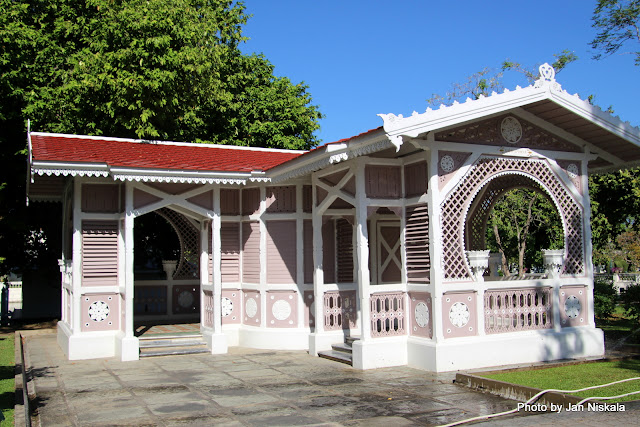Next: Travel to Ayutthaya, Thailand
We
leave Bangkok and travel by bus to the city of Ayutthaya. This served as the second Siamese Capitol for
over 400 years and was once glorified as one of the largest cities in Southeast
Asia. Ayutthaya is a modern Thai city studded with
archeological wonders.
Our first stop in Ayutthaya is the UNESCO World
Heritage Site of the Ayutthaya Historical Park.
The park comprises
ruins of towers, monasteries, temples and palaces of the capital of the ancient
Ayutthaya Kingdom. The city of Ayutthaya was founded by King
Ramathibodi I in 1351. It was captured by the Burmese in 1569. Though not
pillaged, it lost many valuable and artistic objects. The beautiful city was the
capital of the country until its destruction by the Burmese Army in 1767.


Next
stop: Wat Maha That: Wat Maha That or the 'Monastery of
the Great Relic' is located on a city island in the central part of
Ayutthaya. The monastery stood on the west bank of Khlong
Pratu Khao Pluak, an
important canal which had been covered over sometime in the early 20th century.
In ancient times the temple was likely fully surrounded by canals and moats.
The structure has been registered as a national historic site by the Fine Arts
Department on March 8, 1935 and is part of the Ayutthaya World Heritage Historical Park.
A model of Wat Maha That showing its probable historic appearance was located inside the park.

Wat Maha That is widely used for photography – I hope I did it justice!


From
ruins we travel to splendor as we visit the site of the Bang Pa-In Palace, a
collection of beautiful buildings in various architectural styles.

Ornate buildings are sprinkled across Bang Pa-In Palace's 47 acre gardens. First established in the 17th
century having been built by King Prasat Thong in 1632, it served as the Royal
Summer Palace for the Thai Kings. It
fell to disrepair and became overgrown in the late
18th and early 19th centuries. King Mongkut began to restore the site in the mid-19th century. Most of the present buildings were constructed
between 1872 and 1889 by King Chulalongkor. Then the palace was revived in the 19th century by kings Rama
IV and V, the latter adding most of its European styling. Today an eclectic
assortment of architectural styles is arranged around manicured lawns, including
the intricate Chinese-style Mansion called the Wehart
Chamrun, the orange-and-red-striped lighthouse shaped observatory called
Ho Withun Thasana (1881) and a Thai pavilion that appears to float
on the water.











 |
| How would you like this guy living in your backyard? |

“On pain of death, do not touch Queen Sunandha!”
Sunandha Kumariratana was born on November 10, 1860 as the daughter of King
Mongkut of Siam (Rama IV) and Princess Consort Piam. Sunandha was the first Queen consort of King
Chulalongkorn (Rama V) of Siam and also his half-sister. All of his four
wives were also his half-sisters. King Mongkut (Rama IV) had at least 82
children with various consorts and concubines.
Sunandha Kumariratana had a daughter on August 12, 1878, named
Kannabhorn Bejaratana and she was pregnant again when tragedy struck on
May 31, 1880.
While on the way to the Summer Palace Bang Pa-In the
royal boat she and her daughter were travelling on capsized. There were many
onlookers who witnessed the capsizing: however, they were unable to help as
they were forbidden from touching the Queen on pain of death, even if it meant
that they couldn’t save her life. They were even instructed to do nothing by a
guard on another boat, though he was later punished for his strict view of the
law in such circumstances. It is so sad considering this tragedy could have
been avoided. A memorial for Queen Kumariratana
and her daughter can be found on the grounds of Bang Pa-In Palace while their
ashes are in Memorial at the Royal Cemetery at Wat Ratchabophit.
It’s time to say farewell to this beautiful Palace and grounds.
After dinner we were surprised with a lovely river boat ride to see the sites and to see the Elephants!
Well, the elephants had to go to bed after we all fed them several packages of biscuits! So the boat turns around and starts to head back to the dock. Here are a few of the sights we saw that depict life along the river in Thailand, on the way back.
Wat
Chaiwatthanaram is a Buddhist temple in the city of Ayutthaya Historical Park, on the west bank of the Chao Phraya River. The temple was conceived as a replica of the
Angkor Temple in 1630 by the king Prasat Thong, to honor his mother. It was the
first Temple of his reign. We passed by at sunset.
Heading
back to the dock.
More coming soon 😊
Jan 🌷🌷🐾🐾

























































































































































1 comment:
did you ride the elephant across the river?
Post a Comment